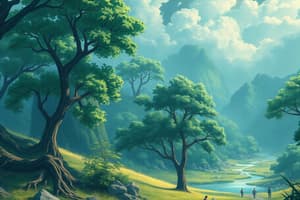Podcast
Questions and Answers
What do secondary consumers in the pond primarily feed on?
What do secondary consumers in the pond primarily feed on?
- Herbivores (correct)
- Green plants
- Phytoplankton
- Dead decaying plant parts
Which animals are considered tertiary consumers in the pond ecosystem?
Which animals are considered tertiary consumers in the pond ecosystem?
- Herbivores at the bottom of the pond
- Larger fish that feed on smaller fish (correct)
- Decomposers
- Zooplankton
What is the primary food source for zooplankton in the pond community?
What is the primary food source for zooplankton in the pond community?
- Dead decaying plant parts
- Phytoplankton (correct)
- Green plants
- Herbivores
What role do decomposers play in the pond ecosystem?
What role do decomposers play in the pond ecosystem?
Which animals are associated with green plants in the pond and feed on them?
Which animals are associated with green plants in the pond and feed on them?
What do birds and domesticated animals like cows and buffaloes feed on in the pond ecosystem?
What do birds and domesticated animals like cows and buffaloes feed on in the pond ecosystem?
Which organisms constitute microconsumers in the pond community?
Which organisms constitute microconsumers in the pond community?
What is the primary role of herbivores located at the bottom of the pond?
What is the primary role of herbivores located at the bottom of the pond?
Which animals are secondary consumers in the forest community?
Which animals are secondary consumers in the forest community?
What is a common feature of autotrophs in both the pond and forest ecosystems?
What is a common feature of autotrophs in both the pond and forest ecosystems?
Flashcards
Population
Population
A group of individuals of one kind in a specific area without genetic barriers.
Population Ecology
Population Ecology
The study of population structures, dynamics, and interactions with the environment.
Population Size Dynamics
Population Size Dynamics
Changes in population size due to birth, immigration, death, and emigration.
Biotic Potential
Biotic Potential
Signup and view all the flashcards
Growth Curves
Growth Curves
Signup and view all the flashcards
J-shaped Growth Model
J-shaped Growth Model
Signup and view all the flashcards
S-shaped Growth Model
S-shaped Growth Model
Signup and view all the flashcards
Community Ecology
Community Ecology
Signup and view all the flashcards
Community Stability
Community Stability
Signup and view all the flashcards
Ecological Succession
Ecological Succession
Signup and view all the flashcards
Study Notes
Population Ecology
- A population is a group of individuals of one kind with no barriers to exchange of genetic material in a given area at a given time.
- Population ecology deals with the structure and dynamics of individuals in a population and their interactions with the environment.
- It plays a significant role in protecting and managing populations, especially rare species, through means like Population Viability Analysis (PVA).
Population Characteristics
- Population size and density keep changing with time due to immigration, emigration, birth, and death.
- If birth + immigration > emigration + death, the population size increases.
- If birth + immigration < emigration + death, the population size decreases.
Biotic Potential
- Biotic potential is the inherent power of a population to grow and reproduce when environmental conditions are favorable and resources are unlimited.
- It is represented by the symbol 'r'.
Population Dynamics
- Populations are never static and keep changing in time and space.
- Changes in population size over time show varied trends, including J-shaped and S-shaped growth curves.
Growth Curves
- J-shaped or Exponential Growth Model: population increases geometrically or exponentially until resource limitation or other factors limit growth.
- S-shaped or Sigmoid or Logistic Growth Model: population growth is limited by resources, showing minimum death during early stages and reaching an upper limit (Carrying capacity, 'K').
Community Ecology
- Community ecology deals with the characteristics, methods of studying, and interactions among different populations in a community.
- Community stability requires two components: Resilience (ability to recover after disturbance) and Resistance (ability to avoid disturbance).
Community Characteristics
- Species richness, diversity, and evenness are important characteristics of a community.
- Richness Index (R), Index of dominance (λ), and Evenness Index (E) are used to measure community characteristics.
Ecological Succession
- Ecological succession is the process of change in species composition of a community over time.
Studying That Suits You
Use AI to generate personalized quizzes and flashcards to suit your learning preferences.
Description
Test your knowledge on Population Ecology topics like Population Characteristics, Dynamics, Growth Curves, and Regulation as well as Community Ecology topics such as Community Characteristics, Methods of Studying, Ecotypes, and Ecological Succession.




